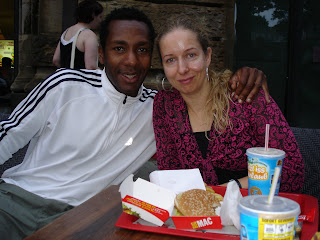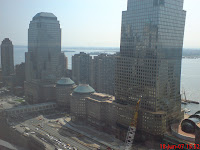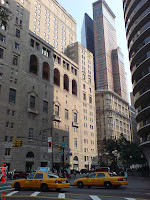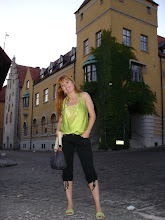
I took a guided tour with Rico Sun Tours to El Yunque rainforest today. Our tour guide and bus driver for the day was an energetic and friendly fellow named Josué (not sure about the spelling but it wasn’t the regular José). That guy was a living encyclopedia! He was an excellent story-teller; knowledgeable about everything from history to social studies and culture to political science – all while being charming and entertaining. I learned a lot from him about Puerto Rico and am very pleased that I decided to take this tour. It makes a world of difference for the experiencing and appreciation of a new place and culture when you know a little of its past and present. If I could only remember one tenth of what he told us, it would make a very interesting summary of the island’s history, culture, population and sauna.
Anyhow, here’s what I remember:
There are three ethnic origins of the people of Puerto Rico: the native Taíno Indians, Spanish conquistadors and African slaves. Today there are 4 million people living in Puerto Rico and the first language is Spanish. The biggest populations of Puerto Ricans outside of Puerto Rico reside in New York, Chicago and San Francisco.
Puerto Rico has belonged to the US with ‘commonwealth status’ for over a hundred years, and has contributed to the US military armed forces, fighting to defend democracy together with US troops since the First World War. After the Spanish-American War in 1898 the island passed to the United States, and in 1903 the US officially proclaimed the Luquillo Forest Reserve which is where we were headed. Timber, bananas, subsistence crops and coffee were once harvested on the forest's lower parts. An 1899 hurricane prompted abandonment of some farms in this area. Subsequently, the Forest Service replanted trees and lands were allowed to return to rainforest. Today, there are only a few houses left in the National Forest and the people living in them have to abide by the Forest Reserve’s strict guidelines in order to preserve the rainforest and its wildlife.
Although Puerto Rico is governed by US federal laws and is an important port and point of trade with Latin America for the US, it is not an own state. Puerto Ricans are not allowed to vote in the Presidential elections. They have to move to any of the other 50 states first and register to vote in order to participate. In order to become the 51st state of the union, the majority of the Puerto Ricans would have to vote yes in a referendum, and the rest of the states in the union accept to let them in. Since Puerto Rico is mainly Democratic, the Republicans would not be too keen on letting in a new state where they’d basically always lose Presidential campaigns in that state. Puerto Rico is also the second most densely populated island in the world (only Singapore has more people per square mile) and if I understood what Josué said correctly, this would mean that they therefore would get more votes / influence over US politics and legislation than other (scarcely populated with lots of land) states that have been part of the union since its start, e.g. Wyoming, which would probably not be seen very favorably by those states.
On the other hand it’s unlikely that Puerto Rico would be ‘allowed’ to become an independent, sovereign state. USA would then risk losing its most important window to South America to Venezuela or Brazil. Puerto Rico has enjoyed a lot of positive trade effects and boosted economy by being part of the US commonwealth, so it’s perhaps not surprising that around 65% of the Puerto Ricans have claimed in recent surveys that they would vote for becoming a new state of the union. On the other hand, when push comes to shove, Puerto Ricans are very protective of their national heritage and one of their biggest national “sports”, cock fighting – which is apparently an 800 billion dollar per year industry(!) – recently became illegal in the last remaining state of the US, Louisiana, which is phasing this old tradition out by the end of this year. Therefore, Josué believed that the final say on the future state of Puerto Rico would not be determined any time soon.
The three main industries in Puerto Rico are pharmaceuticals, rum and tourism. In fact, Puerto Rico is famous for its premium rum (I can’t complain about the Mojitos I’ve had so far) and the quality is ensured by all rum being stored at least a year before it’s bottled and sold. There are 11 brands of rum; the Bacardi Rum is the no 1 brand in the world but not in Puerto Rico – here the Don Q (named after Don Quixote) is the no 1.
El Yunque rainforest was a fantastic experience. It was very humid and felt very hot and I would guess it was around 35° Celsius. After watching a 15 min film at the Visitor’s Center in the Luquillo Forest Reserve and checking out their exhibition to learn a little about different plants and animals in the rainforest, we stopped at the Yokahu Tower, an observation point some 480 m above the sea where you saw the whole east coast of Puerto Rico, including Luquillo Beach – see photos below, although they may not give justice to the colors in the rainforest. Unfortunately I was out of luck with my cameras today (or perhaps badly prepared is more correct) – first, I discovered that my analog system camera was out of battery before I had even taken one single photo (it’s been a while since I used it, since it’s so convenient to carry a small digital camera these days), then I ran out of batteries in my digital camera, so I was left with my Sony Ericsson K810 Cyber-shot phone for the entire rainforest excursion...(not too bad considering).

 Yokahu Tower
Yokahu TowerWe walked along paved trails in the rainforest and saw breadfruit, banana plants with beautiful flowers, thick vegetation of palm trees and bushes, some incredibly large trees, bamboo, tiny lizards (thankfully no snakes as far as I could see!), creeks and waterfalls.
 There were lots of sounds – birds and rustle in the underbrush – and I wished we could have seen some parrots but apparently the green Puerto Rican Amazon Parrot only lives on the higher altitudes and have long been an endangered species although it is now slowly picking up in numbers thanks to the relentless work of the Caribbean National Forest Reserve. There are however 105 species of Coqui (frogs famous for their ‘coqui, coqui’ sound at night, soothing to most Puerto Ricans but a nuisance to some other nationalities who are not used to them), of which 75 are represented in El Yunque rainforest.
There were lots of sounds – birds and rustle in the underbrush – and I wished we could have seen some parrots but apparently the green Puerto Rican Amazon Parrot only lives on the higher altitudes and have long been an endangered species although it is now slowly picking up in numbers thanks to the relentless work of the Caribbean National Forest Reserve. There are however 105 species of Coqui (frogs famous for their ‘coqui, coqui’ sound at night, soothing to most Puerto Ricans but a nuisance to some other nationalities who are not used to them), of which 75 are represented in El Yunque rainforest.



 Breadfruit
Breadfruit
Banana plant with a flower at the end of the stalk










Condensed water in the moss on a tree
La Mina waterfall was a beautiful spot with a wooden bridge after about 20-30 min walk along a forest trail. Here people ‘cooled off’ in the warm water under the falls and played with their kids in the river.
La Mina waterfall was a beautiful spot with a wooden bridge after about 20-30 min walk along a forest trail. Here people ‘cooled off’ in the warm water under the falls and played with their kids in the river.


La Mina falls
On our way back with the tour bus to Carolina we passed a couple of towns along the coast, the biggest one being Luiza with a typical town center with a Catholic church and directly in front of it a town square and next to it the City Hall. The coastal towns predominantly have black population with descendants from African slaves brought to Puerto Rico when the indigenous population of Taíno Indians had diminished and the Spanish colonizing the islands needed more labor. The biggest river in Puerto Rico is the Río Grande de Luiza, which we crossed and saw the river mouth in the Atlantic Ocean.
We also passed another little village just outside Carolina called Piñones with lots of little simple restaurants along the road and live music at night. I will perhaps go back there one evening, enjoy the local beer, Medalla Light, and see what the locals are up to. By the looks of it, they seem to enjoy horse race betting even if on a turn-wheel with miniature horses (I saw several of them within a mile of each other, with locals gathered around)…
On our way back with the tour bus to Carolina we passed a couple of towns along the coast, the biggest one being Luiza with a typical town center with a Catholic church and directly in front of it a town square and next to it the City Hall. The coastal towns predominantly have black population with descendants from African slaves brought to Puerto Rico when the indigenous population of Taíno Indians had diminished and the Spanish colonizing the islands needed more labor. The biggest river in Puerto Rico is the Río Grande de Luiza, which we crossed and saw the river mouth in the Atlantic Ocean.
We also passed another little village just outside Carolina called Piñones with lots of little simple restaurants along the road and live music at night. I will perhaps go back there one evening, enjoy the local beer, Medalla Light, and see what the locals are up to. By the looks of it, they seem to enjoy horse race betting even if on a turn-wheel with miniature horses (I saw several of them within a mile of each other, with locals gathered around)…










































